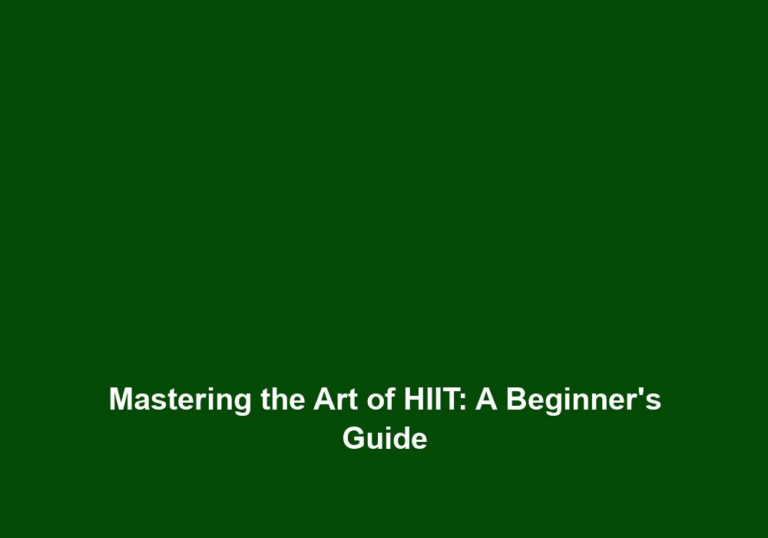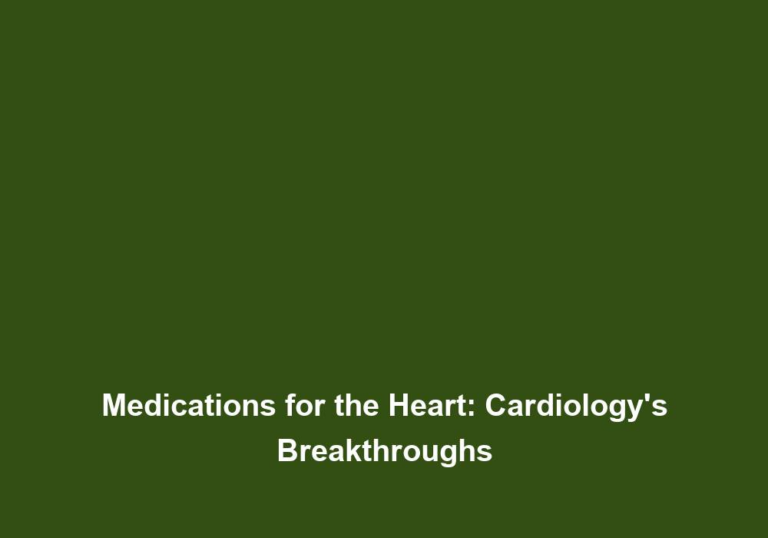Cardio with a Beat: Dancing Your Way to Heart Health
Dancing is not only a fun and enjoyable activity, but it also offers numerous health benefits, especially when it comes to cardiovascular fitness. Engaging in regular dance routines can significantly improve heart health, increase stamina, and enhance overall well-being. In this article, we will explore the various ways dancing can contribute to a healthy heart and provide tips on how to incorporate dance into your fitness routine.
The Cardiovascular Benefits of Dancing
Dancing is an excellent form of aerobic exercise that gets your heart pumping and blood flowing. Here are some of the key cardiovascular benefits that dancing can provide:
1. Improved Heart Health
Engaging in regular dance sessions helps strengthen the heart muscle, making it more efficient at pumping blood throughout the body. This increased efficiency reduces the risk of developing cardiovascular diseases such as heart attacks, strokes, and high blood pressure.
Dancing involves a combination of rhythmic movements that require coordination and involve the entire body. This full-body workout not only increases heart rate but also improves blood circulation, allowing oxygen and nutrients to reach all parts of the body more effectively. As a result, the heart becomes stronger and more capable of meeting the body’s demands for oxygen during physical activity.
2. Increased Endurance and Stamina
Dancing involves continuous movement, which works the cardiovascular system and improves endurance. Over time, as you dance more regularly, you will notice increased stamina and the ability to perform physical activities for longer durations without feeling fatigued.
In addition to improving cardiovascular health, dancing also enhances muscular endurance. The repeated movements and postures involved in various dance styles help tone and strengthen muscles, allowing them to work efficiently for extended periods. This increased muscular endurance contributes to improved overall stamina, enabling you to engage in other physical activities with greater ease.
3. Weight Management
Dancing is a highly effective calorie-burning activity that can aid in weight management. Depending on the intensity and duration of the dance routine, you can burn a significant number of calories, leading to weight loss or maintenance.
Incorporating dance into your fitness routine can help you achieve and maintain a healthy weight. The combination of cardio and resistance exercises in dance routines boosts metabolism and promotes fat burning. Additionally, dancing builds lean muscle mass, which increases the body’s calorie-burning capacity even at rest. This means that even after your dance session, your body continues to burn calories, assisting in weight management.
4. Reduced Cholesterol Levels
Regular dance sessions can help lower bad cholesterol (LDL) levels and increase good cholesterol (HDL) levels. This is important for maintaining a healthy cardiovascular system, as high levels of LDL cholesterol can lead to plaque buildup in the arteries, increasing the risk of heart disease.
Engaging in dance exercises regularly can positively impact cholesterol levels. The aerobic nature of dancing raises HDL cholesterol, which helps remove LDL cholesterol from the bloodstream. Additionally, dance routines that involve high-intensity movements stimulate the production of enzymes that break down fats, further aiding in cholesterol reduction. By incorporating dance into your fitness routine, you can effectively manage your cholesterol levels and reduce the risk of heart disease.
Dance Styles for Cardiovascular Fitness
There are numerous dance styles to choose from, catering to different preferences and fitness levels. Here are a few popular dance styles that provide an excellent cardiovascular workout:
1. Zumba
Zumba is a high-energy dance style that combines Latin rhythms with cardiovascular exercise. It incorporates various dance moves and aerobic techniques to create a full-body workout. Zumba classes are often accompanied by fast-paced music, making it an enjoyable and effective way to improve cardiovascular fitness.
Zumba offers a dynamic and engaging workout that targets various muscle groups while keeping your heart rate elevated. The combination of dance and fitness elements in Zumba routines helps improve coordination, agility, and balance. Whether you’re a beginner or advanced dancer, Zumba classes provide a fun and effective way to enhance cardiovascular fitness.
2. Hip Hop
Hip hop dancing involves dynamic movements and fast-paced routines that engage the entire body. This style incorporates diverse dance elements such as popping, locking, and breaking, providing an intense cardiovascular workout while allowing for self-expression and creativity.
Hip hop dance routines often feature quick footwork, jumps, and energetic body movements. These high-intensity movements elevate heart rate and challenge the cardiovascular system. By practicing hip hop dance, you can improve cardiovascular fitness, coordination, and flexibility while enjoying the rhythm and energy of this popular dance style.
3. Ballet
Ballet may be seen as a graceful and elegant form of dance, but it requires significant strength, flexibility, and endurance. Engaging in ballet classes or routines can improve cardiovascular fitness by combining fluid movements with controlled breathing techniques.
Ballet involves precise and controlled movements that engage both large and small muscle groups. The continuous flow of movements in ballet routines increases heart rate and improves cardiovascular endurance. Additionally, ballet requires deep concentration and mental focus, further enhancing overall well-being. Whether you’re a beginner or have previous ballet experience, incorporating ballet into your fitness routine can provide a unique cardiovascular workout.
4. Salsa
Salsa dancing is not only a social activity but also an excellent way to improve cardiovascular health. The rhythmic footwork, quick turns, and partner interactions increase heart rate and provide a challenging cardiovascular workout.
Salsa involves fast-paced movements that engage the entire body, particularly the legs and core. The combination of aerobic exercise and partner work in salsa routines boosts cardiovascular fitness while improving coordination and balance. Additionally, salsa dancing offers a social aspect, allowing you to connect with others and enjoy the vibrant music and cultural experience. Whether you’re a beginner or experienced dancer, salsa is a fantastic dance style to improve heart health and have fun.
Tips for Incorporating Dance into Your Fitness Routine
If you’re considering adding dance to your fitness routine, here are some tips to help you get started:
1. Find a Dance Class or Instructor
Look for local dance studios or fitness centers that offer dance classes suitable for your skill level. Having a trained instructor guide you through the movements ensures proper form and reduces the risk of injury.
Attending dance classes led by experienced instructors provides a structured environment to learn and progress in your dance journey. Instructors can provide valuable feedback, correct your technique, and offer modifications or progressions based on your individual needs. Additionally, dancing with others in a class setting offers a sense of camaraderie and motivation to keep you engaged and committed.
2. Start Slowly and Progress Gradually
If you’re new to dance or have been inactive for a while, start with beginner-level classes or routines. As you build stamina and confidence, gradually increase the intensity and duration of your dance sessions.
It’s important to listen to your body and avoid pushing yourself too hard in the beginning. Starting with low-impact dance routines allows your body to adapt and gradually increase its cardiovascular capacity. As you become more comfortable with the movements and build strength and endurance, you can gradually progress to more challenging dance styles or longer durations. Remember to pace yourself and enjoy the journey of improving your cardiovascular fitness through dance.
3. Make it a Social Activity
Dancing with a partner or in a group can make the experience more enjoyable and motivating. Consider joining social dance clubs or attending dance events to meet like-minded individuals and make new friends.
Social dancing not only provides an opportunity to connect with others but also adds an element of fun and excitement to your fitness routine. Partner dances like salsa, ballroom, or swing require coordination, communication, and teamwork, making them engaging and interactive. Joining dance communities or attending social dance events can expand your social circle and provide a supportive environment to enjoy the benefits of dancing together.
4. Mix it Up
To keep your dance workouts exciting and prevent boredom, try different dance styles and routines. Experiment with various genres such as jazz, Bollywood, or contemporary dance to challenge your body in different ways.
Exploring different dance styles adds variety to your fitness routine and keeps you motivated to continue dancing. Each dance style has its unique movements, rhythms, and energy, providing a diverse range of cardiovascular workouts. By incorporating a mix of dance styles, you can target different muscle groups, improve coordination and flexibility, and prevent plateaus in your fitness progress. Embrace the versatility of dance and discover new ways to keep your heart healthy and your body moving.
5. Warm-up and Cool-down
Just like any other form of exercise, warming up before dancing and cooling down afterward is essential. Spend a few minutes performing dynamic stretches and light cardiovascular exercises to prepare your body and prevent injuries.
Before starting your dance session, warm up your muscles and joints by performing gentle stretches and mobility exercises. This helps increase blood flow, loosen tight muscles, and prepare your body for the physical demands of dancing. After your dance routine, take the time to cool down by gradually reducing the intensity of your movements and incorporating static stretches. This helps prevent muscle soreness, promotes flexibility, and allows your heart rate to return to its resting state.
In conclusion, dancing is a fantastic way to improve cardiovascular fitness, strengthen the heart, and enhance overall well-being. Whether you prefer high-energy styles like Zumba or more traditional forms like ballet, there is a dance style out there for everyone. So put on your dancing shoes, get moving, and experience the joy of cardio with a beat!







